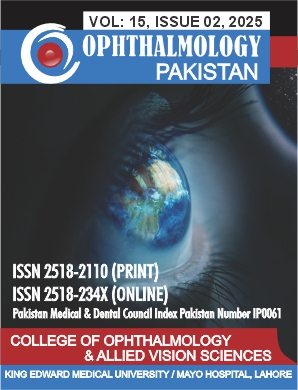Patterns of Posterior Capsular Opacification After Phacoemulsification with Foldable Acrylic Intraocular Lens
DOI:
https://doi.org/10.62276/OphthalmolPak.15.02.195Keywords:
Posterior Capsular Opacification, Phacoemulsification, Acrylic AcidAbstract
Objective: To determine different patterns of posterior capsular opacification after phacoemulsification using foldable (acrylic acid) intraocular lenses.
Methodology: This was cross-sectional study in which 172 patients having senile cataract undergoing phacoemulsification were selected. Patterns of posterior capsular opacification were graded using Sellmen and Lindstrom grading system in the patients who underwent phacoemulsification, using foldable intraocular lens. Examination was done on slit lamp and proforma was filled. Data were entered and analyzed by SPSS v25.0. Data were stratified for age, gender and duration of IOL. Post-stratification, Chi-square test was applied and p≤0.05 was considered significant.
Results: There were 97(56.4%) males and 75(43.6%) were females. Mean age of the patients was 54.32±8.654 year. Mean duration of IOL was 14.25±3.42 months. According to posterior capsular opacification pattern distribution, 40(23.3%) had grade-I, while 73(42.4%), 50(29.1%) and 9(5.2%) had grade-II, grade-III and grade-IV respectively. According to stratification of posterior capsular opacification pattern with respect to different variables, no significant difference was observed between gender, age groups and duration IOL (p>0.05).
Conclusion: Post-phacoemulsification cataract surgery posterior capsular opacification incidence can be reduced, though not totally avoided. An intraocular lens material is an important variable in the development of posterior capsule opacification. Selection of IOL material (Acrylic) goes a long way in minimizing the incidence of post-operative posterior capsular opacification.






